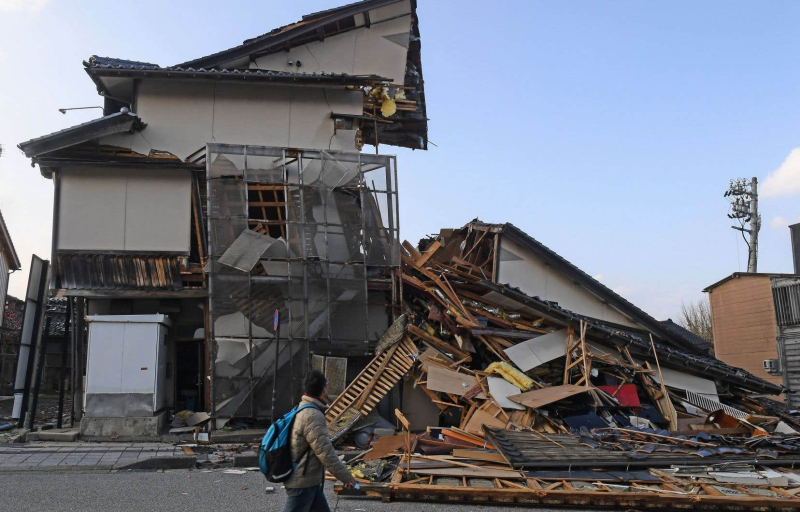
Toshifumi Kitamura Agence France-Presse The 7.5 magnitude earthquake that occurred on the afternoon of January 1 in the Noto Peninsula devastated this narrow strip of land about a hundred kilometers long which juts into the Sea of Japan, causing landslides and collapsing buildings and roads.
Harumi Ozawa – Agence France-Presse and Kyoko Hasegawa – Agence France-Presse to Shiromaru and Tokyo respectively
12:34 p.m.
- Asia
Rescue services continued Saturday to tirelessly search through the rubble of the devastating earthquake that shook central Japan on New Year's Eve and killed at least 126 people according to a new count, with winter weather conditions complicating operations.
According to a new count announced by local authorities, 516 people were also injured and around 210 remain missing. But hopes of finding survivors almost five days after the disaster are dwindling.
The 7.5 magnitude earthquake that occurred on the afternoon of January 1 in the Noto Peninsula devastated this narrow, jutting strip of land about a hundred kilometers long in the Sea of Japan, causing landslides and collapsing buildings and roads.
The tremor, felt as far away as Tokyo, 300 km away, also triggered a tsunami, with waves more than a meter high.
The cold and bad weather complicate the task of rescuers and snow is expected for Sunday, while giant faults and a thousand landslides hamper traffic on the roads.
Two elderly women were rescued from the rubble of their homes on Thursday in Wajima, but there has been little cause for celebration since.
Hit by the tsunami of January 1, Shiromaru, one of the hamlets dotting the coves of the peninsula, is nothing more than a pile of debris of wood, metal and plastic.
“The tsunami came from Shiromaru Cove via the river and then crossed the street,” Toshio Sakashita, 69, told AFP, who estimates his house was submerged by about 2.5 m of water .
“We can no longer live in our house,” says Yukio Teraoka, 82, who is trying with his wife to shovel away the heavy, soggy sand carried into their home by the waves.
Isolated villages
“We sincerely pray for the repose of the souls of those who passed away,” Prime Minister Fumio Kishida said on social media. He called the earthquake and its aftershocks “the most serious disaster” in Reiwa, the Japanese era that opened in 2019 with the accession to the throne of Japanese Emperor Naruhito.
At another emergency cabinet meeting, he asked ministers to “urgently and promptly” repair roads.
Several countries, including the United States and France, have offered help and many have offered condolences, including China and North Korea, whose leader Kim Jong Un expressed his “deep compassion” according to the KCNA agency. .
More than 30,000 people were refugees on Saturday in 366 government shelters, according to the Ishikawa department where the Noto peninsula is located, in often precarious conditions, particularly in the most difficult to access areas.
“I don’t think we received equipment or food in substantial quantities,” Takushi Sakashita, 59, from the village of Noto at the tip of the peninsula, told AFP .
“We are trying our best to carry out rescue operations in remote villages […]. However, the reality is that their isolation has not been resolved as much as we would like,” Hiroshi Hase, the governor of Ishikawa, admitted on Friday.
Almost 25,000 homes remained without electricity and more than 70,000 without water on Saturday morning in this department and two others located further north.
Avoid the influx
In order not to hinder relief operations and the delivery of food, local authorities have called on people outside the Noto peninsula, usually a tourist destination, to avoid going there for “non-essential and non-urgent travel”.
They also asked those who would like to volunteer for the clearing operations to wait until the end of the three-day weekend – this Monday being a public holiday in Japan – due to the lack of organization to be able to welcome and direct them.
Located on the Pacific Ring of Fire, Japan is one of the countries where earthquakes are most frequent.
The archipelago is haunted by the memory of the terrible 9.0 magnitude earthquake followed by a giant tsunami in March 2011 on its northeastern coasts, a disaster which left some 20,000 dead and missing .
This disaster also led to the Fukushima nuclear accident, the most serious since Chernobyl in 1986.

